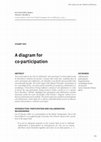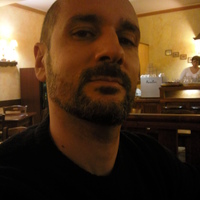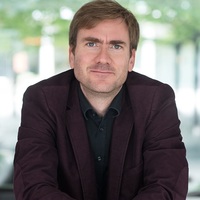Papers by Stuart Tait
Plastique Fantastique -Text: David Burrows, Mark Jackson, Simon O’Sullivan, Stuart Tait Images: A... more Plastique Fantastique -Text: David Burrows, Mark Jackson, Simon O’Sullivan, Stuart Tait Images: Ana Benlloch, David Burrows, Mark Jackson, Alex Marzeta, Vanessa Page, Simon O’Sullivan, Stuart Tait

This thesis begins with the question of whether a collaborative art practice inspired by, or draw... more This thesis begins with the question of whether a collaborative art practice inspired by, or drawing upon, Gilles Deleuze and Felix Guattari's concept of 'the rhizome', and the notions of movement and change it implies, is possible within the structure required of doctoral study. The study is a vital contribution to the knowledge and understanding of contemporary collaborative art practice, with reference to more than half a dozen contemporary collaborative art groups, as well as The Situationist International, Zurich Dada and Fluxus, the thesis explores the composition and maintenance of collaborative practices. The study's art-practice-as-research has focused on the production of unexpected events or 'glitches' and the problems of hierarchy and control where roles such as 'collaborator' and 'participant' come into contact. The relations in and between collaborative groups are considered in terms of what Deleuze and Guattari call 'molaris...

Art & the Public Sphere, 2011
Keywords collaboration participation diagrammatics assemblage theory art practice Actor-Network T... more Keywords collaboration participation diagrammatics assemblage theory art practice Actor-Network Theory glitch stuart tait a diagram for co-participation abstract This article explores the roles of 'collaborator ' and 'participant' in what might loosely be described as collective art practice. I propose that social roles, including those of artist, participant and collaborator, are altogether more flexible and permeable than conventionally thought. The article begins with Manuel DeLanda's development of his 'assemblage theory' of society and the possibility of considering collaborations as assemblages. I then discuss Erving Goffman's concept of 'role adjustments' in order to discuss the way participants change positions within a project as it is enacted; Pierre Bourdieu's 'Habitus' highlights how participants and collaborators orientate themselves within the social; and finally, Gilles Deleuze's 'diagram' outlines how a theory of collectivity can be multiple. The article argues for a synthesis of participation and collaboration, which allows for a reflexive and performative process of collective practice that produces a collective social space.

Co-written by Stuart Tait and Jonathan Waring. Presented at Virtual Futures 2.0 conference, Warwi... more Co-written by Stuart Tait and Jonathan Waring. Presented at Virtual Futures 2.0 conference, Warwick University, 19 June 2011.
Published 2013 in The Live Art Almanac Volume 3.
The presentation will discuss the work of UK-based art group Reactor from the perspective of one ‘guest’ member, Stuart Tait, and one ex or virtual member, Jonathan Waring. The presentation will take the form of a dialogue between Tait, who will be present at the conference, and Waring, who will be presenting via video projection.
Reactor’s practice creates ‘microcosmic worlds’ that thematically draw upon recognisable social forms, such as totalitarian states or self-help groups, in what artist and writer David Burrows refers to as ‘performance fictions’. These new collectivities are then performed or enacted in collaboration with audience-participants who take up positions within the work.
The presentation will begin by considering Reactor projects as ‘assemblages’, drawing upon the writing of Gilles Deleuze and Félix Guattari, and Manuel DeLanda’s development of their work in his Assemblage Theory of society. Erving Goffman’s concept of ‘role adjustments’ will then be used to discuss the way participants’ change positions within a project as it is enacted. The presentation will explore the relationship between the project, as it is actualised, and its virtual dimensions, such as the characteristics of a particular role, back-story for the project, memory, or project planning. Finally, Deleuze and Guattari’s concept of the diagram will be discussed in relation to Bergson’s cone diagram and the counteractualisation of the project back into the virtual of co-participants’ minds.
Thesis Chapters by Stuart Tait

This thesis begins with the question of whether a collaborative art practice inspired by, or draw... more This thesis begins with the question of whether a collaborative art practice inspired by, or drawing upon, Gilles Deleuze and Félix Guattari’s concept of ‘the rhizome’, and the notions of movement and change it implies, is possible within the structure required of doctoral study. The study is a vital contribution to the knowledge and understanding of contemporary collaborative art practice, with reference to more than half a dozen contemporary collaborative art groups, as well as The Situationist International, Zurich Dada and Fluxus, the thesis explores the composition and maintenance of collaborative practices. The study’s art-practice-as-research has focused on the production of unexpected events or ‘glitches’ and the problems of hierarchy and control where roles such as ‘collaborator’ and ‘participant’ come into contact. The relations in and between collaborative groups are considered in terms of what Deleuze and Guattari call ‘molarising’ and ‘molecularising’ forces, and the research included the discovery of new forms of what I have termed ‘Molecular collaboration’.
The study seeks to address perceived weaknesses in certain (dominant) Marxist forms of critical/dialectical practice in relation to art by exploring alternative, more anarchist approaches to relations, roles and types of group organisation. The work of Manuel DeLanda on ‘assemblage theory’ and Erving Goffman’s concept of ‘role adjustments’ are combined with Deleuze and Guattari’s ‘diagrammatics’ to develop the new concept of ‘Molecular collaboration’.
Molecular collaboration is an important concept because it frees collaborative working from the burden of individual and group identity by allowing creativity to be expressed immanently within a network of relations rather than in relation to any specific ideal or structure.
Conference Presentations by Stuart Tait











Uploads
Papers by Stuart Tait
Published 2013 in The Live Art Almanac Volume 3.
The presentation will discuss the work of UK-based art group Reactor from the perspective of one ‘guest’ member, Stuart Tait, and one ex or virtual member, Jonathan Waring. The presentation will take the form of a dialogue between Tait, who will be present at the conference, and Waring, who will be presenting via video projection.
Reactor’s practice creates ‘microcosmic worlds’ that thematically draw upon recognisable social forms, such as totalitarian states or self-help groups, in what artist and writer David Burrows refers to as ‘performance fictions’. These new collectivities are then performed or enacted in collaboration with audience-participants who take up positions within the work.
The presentation will begin by considering Reactor projects as ‘assemblages’, drawing upon the writing of Gilles Deleuze and Félix Guattari, and Manuel DeLanda’s development of their work in his Assemblage Theory of society. Erving Goffman’s concept of ‘role adjustments’ will then be used to discuss the way participants’ change positions within a project as it is enacted. The presentation will explore the relationship between the project, as it is actualised, and its virtual dimensions, such as the characteristics of a particular role, back-story for the project, memory, or project planning. Finally, Deleuze and Guattari’s concept of the diagram will be discussed in relation to Bergson’s cone diagram and the counteractualisation of the project back into the virtual of co-participants’ minds.
Thesis Chapters by Stuart Tait
The study seeks to address perceived weaknesses in certain (dominant) Marxist forms of critical/dialectical practice in relation to art by exploring alternative, more anarchist approaches to relations, roles and types of group organisation. The work of Manuel DeLanda on ‘assemblage theory’ and Erving Goffman’s concept of ‘role adjustments’ are combined with Deleuze and Guattari’s ‘diagrammatics’ to develop the new concept of ‘Molecular collaboration’.
Molecular collaboration is an important concept because it frees collaborative working from the burden of individual and group identity by allowing creativity to be expressed immanently within a network of relations rather than in relation to any specific ideal or structure.
Conference Presentations by Stuart Tait
Published 2013 in The Live Art Almanac Volume 3.
The presentation will discuss the work of UK-based art group Reactor from the perspective of one ‘guest’ member, Stuart Tait, and one ex or virtual member, Jonathan Waring. The presentation will take the form of a dialogue between Tait, who will be present at the conference, and Waring, who will be presenting via video projection.
Reactor’s practice creates ‘microcosmic worlds’ that thematically draw upon recognisable social forms, such as totalitarian states or self-help groups, in what artist and writer David Burrows refers to as ‘performance fictions’. These new collectivities are then performed or enacted in collaboration with audience-participants who take up positions within the work.
The presentation will begin by considering Reactor projects as ‘assemblages’, drawing upon the writing of Gilles Deleuze and Félix Guattari, and Manuel DeLanda’s development of their work in his Assemblage Theory of society. Erving Goffman’s concept of ‘role adjustments’ will then be used to discuss the way participants’ change positions within a project as it is enacted. The presentation will explore the relationship between the project, as it is actualised, and its virtual dimensions, such as the characteristics of a particular role, back-story for the project, memory, or project planning. Finally, Deleuze and Guattari’s concept of the diagram will be discussed in relation to Bergson’s cone diagram and the counteractualisation of the project back into the virtual of co-participants’ minds.
The study seeks to address perceived weaknesses in certain (dominant) Marxist forms of critical/dialectical practice in relation to art by exploring alternative, more anarchist approaches to relations, roles and types of group organisation. The work of Manuel DeLanda on ‘assemblage theory’ and Erving Goffman’s concept of ‘role adjustments’ are combined with Deleuze and Guattari’s ‘diagrammatics’ to develop the new concept of ‘Molecular collaboration’.
Molecular collaboration is an important concept because it frees collaborative working from the burden of individual and group identity by allowing creativity to be expressed immanently within a network of relations rather than in relation to any specific ideal or structure.